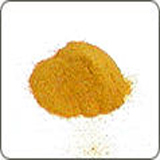Azomethine H
111Category: Organic chemicals and Derivatives

CAS NO: 32266-60-7 EC NO: 250-975-3 Molecular Formula: C17H11NO8S2 Molecular Weight: 421.4022 Specification: InChI: InChI=1/C17H13NO8S2/c19-15-4-2-1-3-10(15)9-18-14-7-12(27(21,22)23)5-11-6-13(28(24,25)26)8-16(20)17(11)14/h1-9,18,20H,(H,21,22,23)(H,24,25,26)/p-2 Product description:
Storage: Ambient Temperature
Shipping Condition: Ambient Temperature
Chemical Name: 8-Hydroxy-1-(salicylideneamino)-3,6-naphthalenedisulfonic acid, disodium salt
CAS Number: 32266-60-7, 5941-07-1: Na, H2O
Appearance: yellowish orange or yellowish brown crystalline powder
Absorbance(6ppm boron solution): >0.90 (413 nm)
Sulfated ash: <36 %
Solubility: 0.9 g/30 ml, 6.7% ascorbic acid solution100 ml water
Azomethine H is a colorimetric reagent for boron detection; it forms an orange complex with boron in aqueous solution. The molar absorptivity of this complex is 1.01x104 at 415 nm. The detection range of boron in sample solutions is 1-6礸/ml. To detect boron in plant samples, EDTA is used to mask cupper, iron, and aluminum ions. Azomethine H is used to detect microgram levels of boron in glass and steel samples.
Synonyms: Azomethine H;2,7-Naphthalenedisulfonic acid, 4-hydroxy-5-(((2-hydroxyphenyl)methylene)amino)-;4-Hydroxy-5-(((2-hydroxyphenyl)methylene)amino)naphthalene-2,7-disulphonic acid;4-hydroxy-5-{[(6-oxocyclohexa-2,4-dien-1-ylidene)methyl]amino}naphthalene-2,7-disulfonic acid;4-hydroxy-5-{[(6-oxocyclohexa-2,4-dien-1-ylidene)methyl]amino}naphthalene-2,7-disulfonate;4-Hydroxy-5-(salicylidene-amino)-2,7-naphthalenedisulfonic acid;8-Hydroxy-1-(salicylideneamino)-3,6-naphthalenedisulfonic acid; Molecular Structure: 



